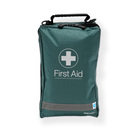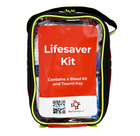Dental Injuries
Want to watch this video? Sign up for the course
or enter your email below to watch one free video.
Unlock This Video Now for FREE
This video is normally available to paying customers.
You may unlock this video for FREE. Enter your email address for instant access AND to receive ongoing updates and special discounts related to this topic.
Dental Injury First Aid: Protecting and Treating Tooth Damage
Seeing a Dentist for Dental Injuries
Understanding when to seek dental care and how to provide initial aid for common dental injuries.
Chipped or Broken Tooth
Addressing a chipped or broken tooth before reaching the dentist:
- Protect the Mouth: Shield the injured area to prevent exposure to cold, especially when the injury has exposed a nerve.
- Consulting a Dentist: Schedule an appointment with a dentist for assessment and treatment.
Knocked-Out Tooth
Immediate steps to take when a tooth is knocked out:
- Locate the Tooth: If possible, find the dislodged tooth.
- Clean the Tooth: Rinse it with saline solution or milk to remove contaminants.
- Proper Reinsertion: Ensure the tooth is correctly oriented and firmly push it back into place.
- Stabilize with a Gum Shield: If available, use a gum shield to hold the tooth in position.
- Seek Dental or A & E Care: Visit a dentist for treatment, or if one isn't accessible, consider the Accident & Emergency department with oral surgery staff.
Pain Management
How to alleviate pain associated with dental injuries:
- Over-the-Counter Painkillers: Use pain relievers typically taken for headaches.
Post-Injury Care
Ensuring the patient is comfortable and prepared for dental treatment:
- Clean-Up: Address any bleeding, and be aware of potential lip injuries.
- Comforting Children: Keep young patients calm, as blood may be distressing to them.
Remember
Timely dental care is crucial for managing dental injuries effectively.
Recommended Products For You
WoundClot Trauma 8cm x 100cm
£39.95 + VAT
WoundClot Trauma 20cm x 30cm
£37.95 + VAT
iPAD SPR Semi Automatic Defibrillator
£925.00 + VAT
First Aid Kit In Green Pouch
£9.99 + VAT
Lifesaver Kit with Tourni-Key - Red
£85.00 + VAT
Lifesaver Kit with Tourni-Key - Green
£85.00 + VAT
DefibSafe DS3 AED Cabinet IP66 Yellow/Green
£495.00 + VAT
_-Trauma_8x100_CE.jpg)
_-Trauma_20x30_CE.jpg)




